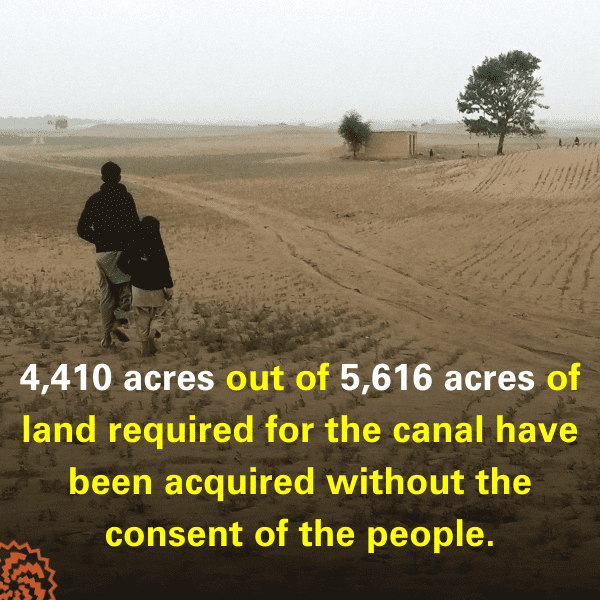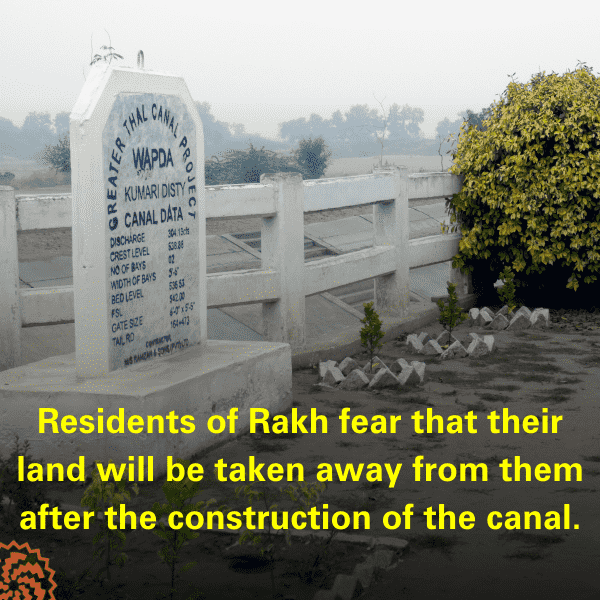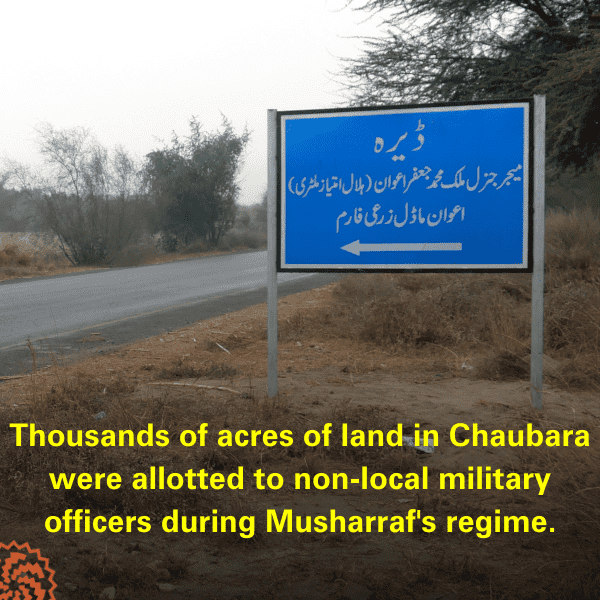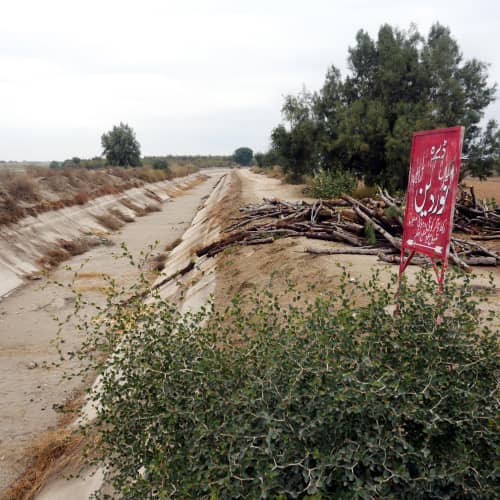Mureed Hussain is visibly happy over the light rain falling on sand dunes spread out before him in the Thal desert. As he watches his land thirstily absorb the raindrops on a cold afternoon in January, 2022, his features betrays a certain satisfaction.
Fragile shoots have appeared in his field of chickpeas, spread over an area of 10 acres. They look greener after washing in the rain. “The rain has come at the right time and its likely to increase the yield of chickpea yield by double or triple,” said Hussain.
He said the chickpea crop did not require much water between the months of November to December. However, if the crop received rain thrice before the month of April, the yield was likely go up to 1000 kilogram per acre. Otherwise, it yields little, something close to about 200 kilograms per acre.
Mureed Hussain is 52. These past five years he has lived in the Nawankot village of Chaubara tehsil of Layyah district in southwestern Punjab, with his wife, two daughters and a minor son. Their two room house, made of burnt clay-brick, is without a boundary wall, surrounded by sand dunes and chickpea fields. In addition to the house, 10 goats and two camels make up for what are his chief assets.
The land he tills, about 25 acres of it, belongs to a retired military officer belonging to Faisalabad. It comprises acres of dunes, high and low. With no water supply, he is unable to plant crops on most of it. It is lands like this that the Chaubara Branch Cannal (CBC), part of the Greater Thal Canal, is meant to irrigate.
The CBC is being built in the Thal desert to help enhance agricultural production in districts of Punjab currently dependent on rain-fed agriculture. The project area falls within the boundaries of Bhakkar, Layyah, Khushab, Jhang and Muzaffargarh districts. The Greater Thal Canal itself starts at Chashma-Jhelum Link Canal at Adhikot area of Khushab district. The GTC, built in the year 2000, will have four branches to irrigate districts of Mianwali, Khushab, Layyah and Jhang districts, according to official documents. However, only the Mankera branch of the proposed four branch canals has been completed thus far.

The main CBC canal would be about 71 kilometres long, with auxiliary canals of 251 kilometres branching out to carry water to smaller canals spread over an area of 124 kilometres.
The completion of the project in 2028, say government planners, would make possible irrigation of 294,000 acres of agricultural land.
According to the website of the Asian Development Band that is paying 200 million dollars of the CBC's 250 million dollars construction cost, the project will benefit about 38,000 farmers, majority of them owners of less than 12.5 acres.
Community reservations over the project
The Thal desert that starts in the Mianwali, a district in the west of Punjab between Jhelum and Sindh River, stretches through Khushab, Jhang, Bhakkar and Layyah districts in a triangular shape to end in Muzaffargarh district. The desert's length is about 306 kilometres and its widest point reaches 113 kilometres.
Most farmers in Thal farmers like Mureed Husain have small land holdings or till other people’s land. Others who are relatively well-heeled like Ahmed Ali Baseer have leveled their lands, digging tube-wells to cultivate wheat and millet besides the staple chickpeas.
Ahmed Ali Baseer is originally from the Okara district in Punjab but his father, who worked as a land-record officer (patwari) in the revenue department allotted himself 60 acres of land in the Village 10 MR at Mankhera tehsil of Bhakkar district in Punjab. This was a couple of years after the plan for Greater Thal Canal construction was floated.
The Water and Power Development Authority (WAPDA) started work on the construction of the Mankera branch in 2002 which was completed in 2008. The land acquisition process for the Chaubara branch had started in 2006 but lack of financial resources stalled construction work on the project.
It was started again in 2018 after the ADB agreed to fund the project and provide technical expertise for the project.

The government requires 6516 acres of land for the Chaubara branch. An August 2021 report about the project's construction stated that 4410 acres were acquired without the land owner's consent. The remaining was government-owned land, with a major portion of it comprising rakhs, or the land kept or reserved for "common" use and forest plantation.
Government documents show two changes have been made to the CBC design recently. One of these is due to a poultry farm located about seven kilometres east of Mankera. The poultry farm is reportedly owned by Akram Cheema, a member of the National Assembly (MNA) affiliated with the ruling Pakistan Tehrik Insaf.
According to the original design, about five and a half acres of this poultry farm land was to be used for the Chaubara Branch Canal. The area in question had three chicken sheds, some offices and an open yard for which MNA Cheema reportedly demanded millions of rupees as compensation. The government instead of paying for this land decided to change the canal design.
Official documents showed that the government has had to acquire an additional 12.5 acres of land, costing 4.4 million rupees, due to the design change. This additional tract of land also includes 13 Kanal of commercial land in Chak 9 MR, owned by one Mumtaz Hussain, with a general provision store and a motorcycle repairing workshop on it.
"The government has put our livelihood in jeopardy while protecting the interests of the poultry farm’s influential owner," said Hussain. "I had purchased his tract of land keeping in view the original design of the project, thinking its value would appreciate in future due to its proximity to the canal."
He said that the government was now giving him 815,000 rupees in compensation, which was far lower than the actual price of land.
Mumtaz’s son Manzar Hussain has approached the Punjab Irrigation Department for restoration of the old design of the canal. "Otherwise, we would be forced to seek recourse to the court," he said.
Also Read

Water, water everywhere nor a drop to drink: Water reservoirs built for power plants imperil a thirsty Tharparkar village
Another member of the local community, Ahmed Ali Baseer, is also unhappy with the canal’s design. He said that under the 2017 survey, four acres of his land was to be acquired for the construction of canal but now authorities were seeking six acres of his land.
"The government compensation of per acre of land at 250,000 rupees to 400,000 rupees is far less than the land prices in the area," he said. "An acre of land in the area cost up to 1 million rupees."
Ghulam Hussain and Muhammad Khalid, both residents of Khan Muhammad Wala village of Chaubara tehsil of Layyah district, find the government compensation for land similarly unfair.
Both villagers claimed that they had been paid 100,000 rupees for 2.5 acres of land when the market worth of an acre of land stood between 2 million rupees to 2.5 million rupees.
Muhammad Waris, a land-record official at Mankera tehsil that they had marked the acquired land with white flags. "About 50 per cent of the land owners [from whom the land was acquired] have also been compensated," he said.
Forest vs Agriculture
The amended Forests Act 1927 stipulates that the provincial cabinet can change the land use of a designated forest only for projects crucial to national security. However, it is debatable whether the Chaubara Branch Canal fall under that definition at all.
Villagers complain that rakhs or "kept" land, originally reserved for growing forests and used by villagers as grazing land was being made part of the Chaubara Branch Canal.
Construction of the canal, they said, would deprive them of their grazing lands.
Nazeer Hussain, a resident of Basti Malana, located about a few kilometres from Chaubra, and some other locals who rear cattle for livelihood are of the view that the canal would convert many of the Thal’s rakhs or "kept" lands into agricultural, bringing a complete end to grazing lands in the area.

Ashiq Ali, a 60 years old camel breeder who lives in a hut near Chaubara, said that the end of grazing lands would affect thousands of families dependent on rearing animals.
The locals also fear that following the construction of the canal the rakhs or reserved land would be allotted to the non-local military officers. They claim that this had started with the construction of the Greater Thal Canal and so far thousands of acres of rakhs lands had been allotted to military officers.
Revenue officials at Mankera acknowledged that lands had been allotted to military officers in the area. These officers, they said, owned thousands of acres of land in parts of Thal where water was available.
A Chaubara forest department official said on the condition of anonymity that between 1999 to 2008, under the military ruler General Pervez, 2000 acres of land was allocated to military officers in the Rakh Dagar Kotala area near Mankera. Similarly, large tracts of land in Rakh Karlu Wala, Rakh Baba Honda Wala and Rakh Cheekan also went to military officers.
The locals protested against these allotments on many occasions during Musharraf's rule, even staging a sit-in in the provincial capital of Lahore. They said the protests somehow slowed down the allotment process or by now, all the area lands would have been allotted to the military.
The most negative impact of the allotment, according to the locals, was that those allotted the lands chopped down the forest trees on large scale to clear land for cultivation of crops.
As an example, they cite the Rakh Dagar Kotli’s huge and dense forest, which has been completely cleared of trees and vegetation to make land available for crop cultivation.
Published on 21 Aug 2022




















